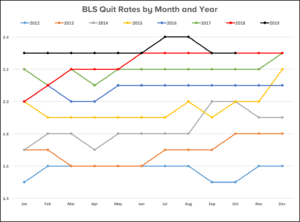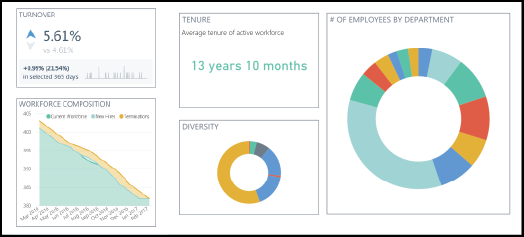New Year, New Strategy: “Stay Interviews” to Avoid “Exit Interviews”

We all keep hearing about the highly-competitive wars for talent in today’s job market. Quit rates from the Bureau of Labor Statistics provide a visual demonstration of this story (see chart below). Until an employer is directly impacted, though, it always seems to be someone else’s problem. The point quickly sinks in, when an employer unexpectedly loses a top employee.
So how do you keep your best talent from leaving? The answer is simple. Just ask them what makes want to stay and what would make them want to leave during a Stay Interview.
What is a Stay Interview?
Stay Interviews are short, one-on-one discussions between a manager and key employee to find out what the employee likes about his/her job and what he/she may find frustrating. The manager should have a brief set of questions to help learn how to keep the employee engaged as well as any potential changes that should be made to limit unnecessary challenges for the employee to complete his/her tasks or projects.
These interviews are much more valuable than Exit Interviews for several reasons:
- In an Exit Interview you have ALREADY LOST the employee.
- Most departing employees will not be upfront in Exit Interviews about their real reasons for leaving (i.e. they don’t want to burn bridges).
- Any attempts to convince an employee to stay in an exit interview is a snub to the departing employee and those existing employees who have not quit. It should not take someone quitting for a company to recognize their value.
- Employees feel more valued when you make a proactive effort to prevent them from leaving in the first place.
- Stay Interviews promote open communication with employees and another interface for job performance discussions outside of regular performance reviews.
How do you start?
The first step should be for HR and Management to work together to identify key talent to interview. Interviews with these employees should then be scheduled ideally within a 2-3 week window of each other. This will allow everyone to note possible themes or common issues and address them quickly before they become greater problems. Stay Interviews should be conducted with the same individuals twice per year to encourage ongoing dialogue and follow up on action items from prior meetings. Ensure that the employee knows up front why they are being asked to participate in the meeting.
What should you tell the selected employees?
Be up front with each employee. First, thank the employee for attending the meeting. Next, explain that the company is very pleased with his/her job performance. The manager should indicated a desire to retain the employee and to use his/her valued feedback in implementing or improving the company’s employee engagement and retention programs.
What questions should be asked?
Open-ended questions are best and should be worded to elicit candid responses. Here are some examples of good questions:
- As you head into work each day, what makes you excited to come here?
- What are 3 things you think the company does well to make you successful and happy?
- What would you like to learn more about to grow or help with your job?
- Are there any processes or tasks that you find frustrating that could be improved?
- Have you ever reached a point that you have thought about leaving? If so, what caused it?
- Are there any ways I can support you better as a manager?
Managers should be prepared to listen and, if needed, ask additional probing questions. At the end of the interview, the discussions should be recapped and an action plan put into place to be discussed at the next Stay Interview with the employee. The employee should be encouraged to discuss any concerns or suggestions prior to the next meeting with the manager at any time. And, of course, close the interview by once again thanking the employee for his/her time and for doing such a great job.
Other critical components
As with any investment of time or money, companies should track metrics to measure the value of their Stay Interviews. Some key metrics are Turnover Rates, Productivity and Employee Satisfaction. Turnover Rate is one that should be paid close attention to both when starting your Stay Interviews and after completing them. If there is a particularly high Turnover Rate in one department, perhaps that is an indication that there is a problem with that manager. In that case, another manager or a member of your HR team might be better suited to conduct the Stay Interviews.
Workforce attrition is a standard part of human capital management. But in today’s market conditions, employers should be keeping a watchful eye on their turnover rates and keep an open line of communication with employees. The challenge of finding and successfully recruiting talent should also make employers see the value in implementing or improving their employee engagement and retention programs. Stay Interviews can help employers discover what motivates employees, keeps them productive and makes them feel satisfied at work.
With the CheckmateHCM Solution, all of your vital workforce data and analytics like Turnover Rates and productivity is at your fingertips letting you drill down by department and manager. Our intuitive interface for employees, managers and HR lets everyone quickly and security access the information they need. Whether it is PTO balances and past pay statements for workers or absences, performance reviews and job costing reports for managers or recruiting and workforce demographics for HR. We provide frustration-free human capital management for everyone, tailored to meet your unique workforce needs.



